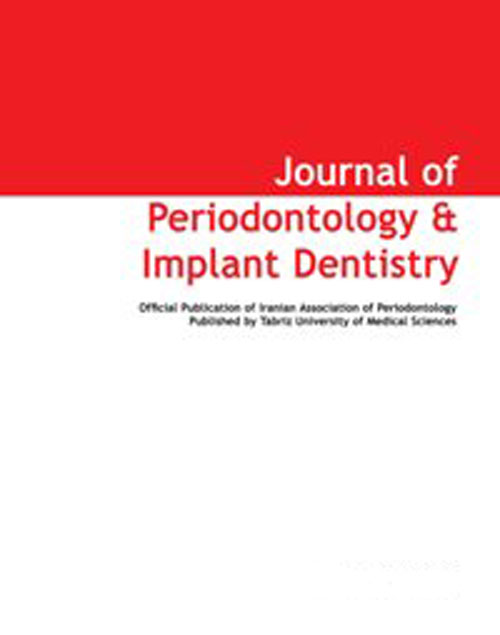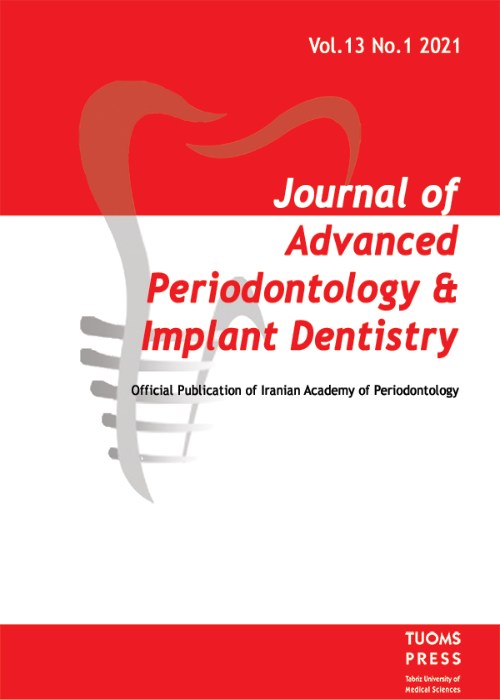فهرست مطالب

Journal of Advanced Periodontology and Implant Dentistry
Volume:9 Issue: 1, Jun 2017
- تاریخ انتشار: 1396/08/02
- تعداد عناوین: 6
-
-
Page 1Background. This project aimed to design, develop and evaluate an integrated professional software package for filing the medical records of patients referred to periodontics departments. The software was intended to provide a range of features, including the availability of voice commands and retrieval of patient information based on different indices and characteristics.
Methods. The overall percentage of satisfaction with the software was 90%. Moreover, 86.66% of the respondents pre-ferred digital dental records to conventional records. Satisfaction in the reduced time of information registration and the advanced search options and availability of voice commands were 84% and 100%, respectively.
Results. The overall percentage of satisfaction with the software was 90%. Moreover, 86.66% of the respondents pre-ferred digital dental records to conventional records. Satisfaction in the reduced time of information registration and the advanced search options and availability of voice commands were 84% and 100%, respectively.
Conclusion. According to the user's opinions, different features of the software, availability of voice commands and advanced search options, facilitated its use and decreased the timerequired for filing medical records. These features increased the users interest in the software.Keywords: Electronic health records, information management system, periodontics, software development -
Page 7Background. As bacterial etiology could not support and explain various aspects of periodontal disease, herpes virus is now proposed to be one of the factors responsible for the periodontal destruction. The aim of the present study was to detect the presence of Herpes simplex virus (HSV) in patients with chronic generalized periodontitis.
Methods. Eleven patients were consecutively selected for the study, of which 3 were diagnosed with moderate chronic generalized periodontitis and 8 with severe chronic generalized periodontitis. Subgingival material was taken from the deepest pocket of the dentition from every study subject, before the commencement of any procedure and polymerase chain reaction (PCR) assay was used to detect the presence of HSV-1 and -2.
Results. HSV-1 and -2 DNA was not detected in any of the samples.
Conclusion. This study is in contrast with previous studies and questions the proposed pathogenic role and clinical relevance of herpes virus in periodontitis.Keywords: Chronic generalized periodontitis, herpes viruses, polymerase chain reaction -
Page 12Background. Despite successful results of implant therapy, complications occasionally occur in challenging situa-tions.Apart from academic courses for implantology, dental associations also offer training courses for general practition-ers.We sought to assess dentist's attitude towards peri-implant diseases.
Methods. The subjects in thisquestionnaire-based cross-sectional study consisted of dentists participating in the annual congress of the Iranian Dental Association in 2013, whose knowledge and attitudes towards peri-implant diseases were assessed using a five-section questionnaire (implant therapy training, peri-implant soft tissue assessment, peri-implant diseases and treatment planning for peri-implant diseases). Data were analyzedwith SPSS 22, using descriptive and analytical methods.
Results. The results showed that due to extensive placement of implants and high prevalence of complications, academic and organized training courses are essential.
Conclusion. The results showed that due to extensive placement of implants and high prevalence of complications, academic and organized training courses are essential.Keywords: Attitude, dentists, implant therapy, knowledge, peri-implantitis -
Page 18Background. This study aimed to assess Aggregatibacter actinomycetemcomitans (Aa) and Prevotella intermedia (PI) counts in gingival crevicular fluid (GCF) around healthy implants, diseased implants and sound teeth.
Methods. Eight patients (four males and four females), who had healthy implants, implants with peri-implantitis and sound teeth, were selected. Samples (GCF) were analyzed using real-time polymerase chain reaction (RT-PCR). The above-mentioned bacteria were detected and counted. Data analysis in RT-PCR was carried out based on the standard curve using Prism software to compare Pi and Aa counts between the three areas (GCF around sound teeth, healthy implants and implants with peri-implantitis).
Results. Pi counts were significantly higher in GCF around implants with peri-implantitis (8 implants) than around healthy implants (8 implants) (PConclusion. Aa and Pi counts in GCF around diseased implants were higher than around healthy implants and sound teeth. Also, Aa counts were significantly higher than Pi counts.Keywords: Dental implant, peri-implantitis, tooth, gingival crevicular fluid, Aggregatibacter actinomycetemcomitans, Prevotella intermedia, bone loss -
Page 26Squamous cell carcinoma (SCC) is one of the most common epithelial malignancies affecting the oral cavity with different clinical presentations. Carcinomas of the gingiva constitute approximately 10% of OSCCs and can mimic reactive, inflammatory conditions of the gingiva, leading to a diagnostic delay. Therefore it is of great importance to diagnose the lesion early for good prognosis. This article reports a rare case of gingival OSCC in a 39-year-old male patient mimicking an inflammatory gingival mass.Keywords: Gingiva, malignancy, squamous cell carcinoma
-
Page 29The maxillary canines rank second after the third molars in terms of the frequency of impaction. The permanent canine teeth play a fundamental role in a functional occlusion and a balanced smile. This study aimed to review the literature and introduce clinical guidelines for surgical canine exposure techniques. The choice of treatment is influenced by several factors such as canine location, severity of impaction, patients age, and other considerations. There are three treatment options, namely observation, exposure and extraction. Based on the location of the impacted canine, the amount of keratinized gingiva and distance from the gingival margin, a flow diagram is introduced for decision-making to choose an appropriate surgical technique.Keywords: Canine, guideline, impaction, surgical exposure


